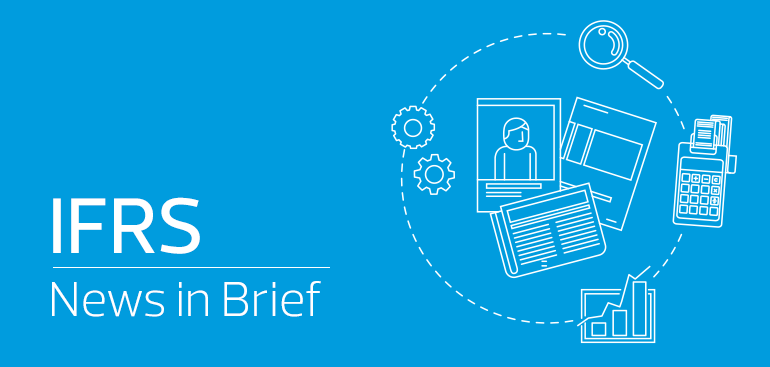PUBLICATIONS AND ANNOUNCEMENTS
The IASB issued the seventeenth edition of the ‘Investor Update’ on 27 November 2018. The issue provides investors with information that helps them keep up to date with changes in the world of IFRS and how those changes may affect their work.
https://www.ifrs.org/news-and-events/2018/11/issue-17-of-the-investor-update-published/
IFRS INTERPRETATIONS COMMITTEE LATEST DECISIONS SUMMARY
The following is a summarised update of the main discussions and tentative decisions taken by the IASB at its meeting on 27 November 2018.
For more details and comprehensive information on the Committee’s discussions see:
https://www.ifrs.org/news-and-events/updates/ifric-updates/november-2018/
Items on the current agenda
The Committee continued its discussion from September on an agenda decision regarding IAS 21 The Effects of Changes in Foreign Exchange Rates in relation to lack of exchangeability. No decisions were made in this meeting and the Committee will continue its discussion in a future meeting.
Committee’s tentative agenda decisions
The Committee tentatively decided not to add the following to its standard-setting agenda because the Committee concluded that the principles and requirements in IFRS provide an adequate basis for the following matters.
- Sale of output by a joint operator (IFRS 11 Joint Arrangements):
The Committee concluded that if the output a joint operator receives in a reporting period is different from the output to which it is entitled, the joint operator recognises revenue that depicts only the transfer of output to its customers in each reporting period, i.e. revenue recognised by applying IFRS 15.
- Physical settlement of contracts to buy or sell a non-financial item (IFRS 9 Financial Instruments):
The Committee concluded that when an entity contacts to buy or sell a non-financial item in the future at a fixed price, IFRS 9 neither permits nor requires an entity to an entity to reassess or change its accounting for a derivative contract solely because that contract is ultimately physically settled
- Over time transfer of constructed good (IAS 23 Borrowing Costs):
The Committee concluded that when the borrowing is related to the construction of a residential multi-unit real estate development for which revenue is recognized over time, borrowing costs should not be capitalized.
- Customer’s right to access the supplier’s software hosted on the cloud (IAS 38 Intangible Assets):
This relates to the situation where a customer contracts to pay a fee in exchange for a right to access the supplier’s application software which runs on cloud infrastructure managed and controlled by that supplier and the customer accesses the software on an as-needed basis over the internet or via a dedicated line. The Committee concluded that:
- a contract that conveys to the customer only the right to receive access to the supplier’s application software in the future is a service contract.
- a software lease is a licensing agreement within the scope of IAS 38, and not of IFRS 16.
- if the customer has the right to use software, it recognises that right-of-use as an intangible asset at the contract commencement date, and the intangible asset is measured initially at cost as required by IAS 38.
- Credit enhancement in the measurement of expected credit losses (IFRS 9 Financial Instruments):
The Committee concluded that, if a credit enhancement is required to be recognized separately by IFRS Standards, an entity cannot include the cash flows expected from it in the measurement of expected credit losses.
- Curing of a credit-impaired financial asset (IFRS 9 Financial Instruments):
The Committee concluded that the reversal of the unwinding of discount is presented as a reversal of credit impairment when the asset is cured.
INTERNATIONAL ACCOUNTING STANDARDS BOARD (IASB) LATEST DECISIONS SUMMARY
The following is a summarised update of the main discussions and tentative decisions taken by the IASB at its meeting on 14-15 November 2018.
For more details and comprehensive information on the IASB’s discussion see:
https://www.ifrs.org/news-and-events/2018/11/november-iasb-update-and-work-plan-updated/
IFRS 17 Insurance Contracts
The Board has tentatively decided to defer the effective date of IFRS 17 Insurance Contracts, and the expiry date of the temporary exemption to IFRS 9 Financial Instruments in IFRS 4 Insurance Contracts by one year.
The Board will continue discussion in the next meeting.
Primary Financial Statements
The Board tentatively decided:
- not to require presentation of EBITDA in the statement(s) of financial performance, nor its disclosure in the notes. However, the Board asked staff to propose a description or definition of EBITDA based on operating profit before depreciation and amortization.
- To develop non-mandatory examples to illustrate the statement(s) of financial performance, cash flows, and notes to clarify how the required line items are presented.
Implementation
- IAS 16 Property, Plant and Equipment:
The Board tentatively decided to proceed with the proposed amendment to IAS 16 Property, Plant and Equipment with some modifications including clarifications on how to identify the costs related to sales of items produced before an item of property, plant and equipment is capable of operating together with disclosure and presentation requirements.
- Cryptocurrencies:
The Board decided not to add to its work plan a project on holdings of cryptocurrencies or initial coin offering at this time. The Board decided to ask the IFRS Interpretations Committee to consider publishing an agenda decision that would explain how entities apply existing IFRS to holdings of cryptocurrencies.
- IAS 37 Provisions, Contingent Liabilities and Contingent Assets:
The Board tentatively decided to permit early application the proposed amendments to IAS 37 in relation to costs of fulfilling a contract.
Management Commentary
The Board discussed the staff’s recommendation that the objective of management commentary should be to given context for the financial statements.The Board will discuss this matter in a future meeting.
Exposure Draft, IAS 1 Presentation of Financial Statements
The Board tentatively decided to make the following proposed amendments to IAS 1 in relation to classification of liabilities as current or non-current:
- A liability should be classified as current if an entity does not have a right at the end of the reporting period to defer settlement of the liability for at least 12 months after the reporting period.
- To add a reminder that an entity’s right to defer settlement must have substance.
- To clarify that an entity’s right to defer settlement is not affected by:
- management’s expectations about whether the entity will exercise the right; and
- settlement of a liability between the end of the reporting period and the date the financial statements are authorized for issue.
Updating a Reference to the Conceptual Framework, IFRS 3 Business Combinations
The Board tentatively decided to begin the updating of IFRS 3 instead of waiting for a possible future project to amend IAS 37, and to develop proposals to avoid conflicts between IFRS 3 and IAS 37 by updating the reference and adding an exception to the initial recognition requirements in IFRS 3.
Rate-regulated Activities
The Board discussed the accounting model being developed for activities subject to defined rate regulation and tentatively decided:
- Interactions between the model and IFRS Standards:
- The measurement requirements of IAS 36 Impairment of Assets and IFRS 5 Non-current Assets Held for Sales and Discontinued Operations should not be applied to regulatory assets and regulatory liabilities.
- The model should include application guidance, but not an explicit statement, about its interaction with IAS 12 Income Taxes.
- The model should not carry forward the related presentation and disclosure requirement in IFRS 14 Regulatory Deferral Accounts.
- Any requirements and application guidance on interactions between the model and other IFRS should be included in a future Standard on rate-regulated activities, rather than adding to those other Standards.
- Presentation and disclosure decisions:
- An entity should present regulatory assets and liabilities as separate line items, apply IAS 1, classifying as current or non-current, and offset regulatory assets and liabilities only when they are expected to lead to adjustments to the same future rate(s) charged to customers.
- An entity should present regulatory income and expenses in profit or loss rather than in other comprehensive income, netted as separate line items, and immediately below the revenue line item(s) required by IAS 1.
- An entity would not be prohibited from disaggregating the required line items and presenting additional line items or subtotals in the primary financial statements when it is relevant to an understanding of the entity’s financial position or performance as required by IAS 1.
- Disclosure objectives and requirements and illustrative disclosures
- The overall disclosure objective for defined rate regulation should be focused on the effects that the transactions or other events that give rise to regulatory timing differences have on an entity’s financial performance and financial position.
- The specific disclosure objectives should focus on information to help users of financial statements:
- to understand the effects of regulatory timing differences on the entity’s financial performance by distinguishing between: (1) fluctuations in revenue and expenses compensated for through the rate-adjustment mechanism; and (2) fluctuations in revenue and expenses for which there is no such compensation;
- to understand and assess the amount, timing and uncertainty of (prospects for) future cash flows that will result from the entity’s regulatory assets and regulatory liabilities; and
- to understand how the entity’s financial position was affected during the period by transactions or other events that caused changes in the carrying amounts of regulatory assets and regulatory liabilities.
- An entity should disclose
- a breakdown of the regulatory income or expense line item in profit or loss into defined components,
- a maturity analysis of the carrying amounts of regulatory assets and liabilities at the end of the period,
- the discount rate(s) used to discount the estimated cash flows reflected in the carrying amounts of regulatory assets and liabilities at the end of the period, and
- a reconciliation of the carrying amount of regulatory assets and liabilities from the beginning to the end of the period.
- The entity should assess whether the information provided through the disclosure requirements is sufficient to meet the overall disclosure objective.
UPCOMING COMMENT DEADLINES
| 7 January 2019 | DP/2018/1 - Financial Instruments with Characteristics of Equity |





